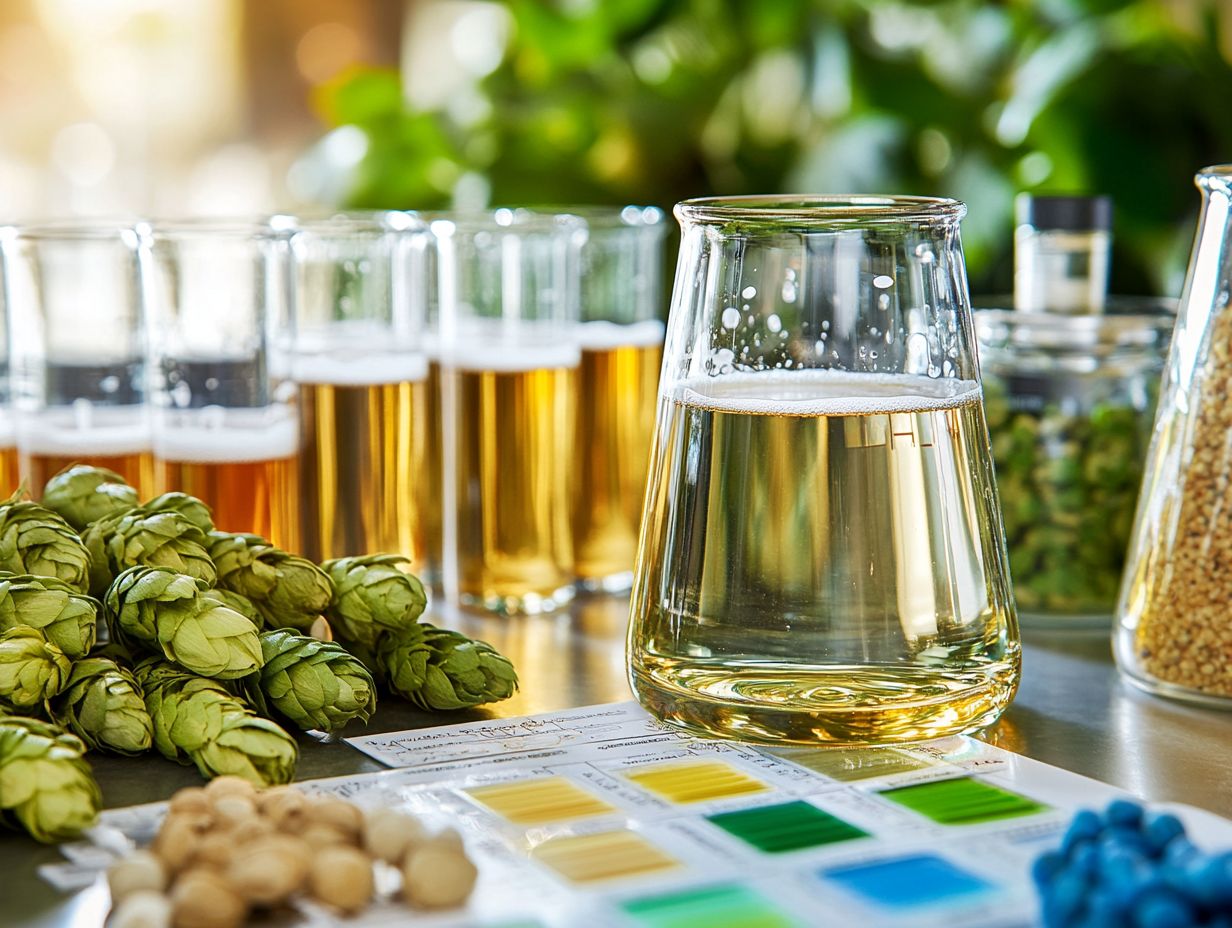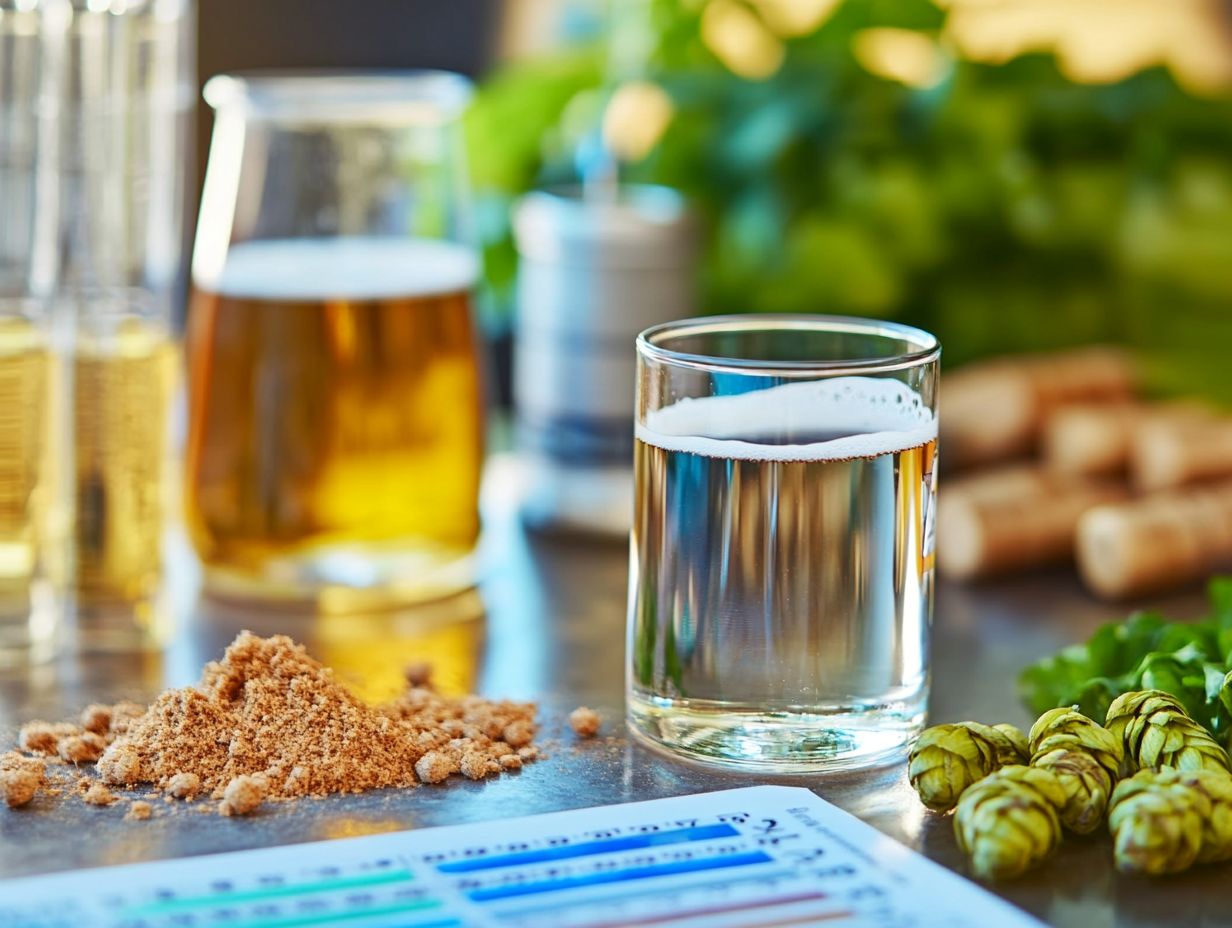The Importance of pH in Brewing Water
Contents
- The Importance of pH in Brewing Water
- Key Takeaways:
- What is pH and Why is it Important in Brewing Water?
- How to Test the pH of Brewing Water?
- How to Adjust the pH of Brewing Water?
- What Are the Different Methods for Adjusting pH in Brewing Water?
- What Other Factors Should Be Considered for Optimal Brewing Water?
- Frequently Asked Questions
- What is the importance of pH in brewing water?
- How does pH affect enzymatic activity during mashing?
- Does the pH of brewing water affect the solubility of minerals?
- What happens if the pH of brewing water is too high?
- Can the pH of brewing water be adjusted?
- What happens if the pH of brewing water is not properly controlled?
The Importance of pH in Brewing Water
If you’re passionate about brewing beer, understanding pH is your secret weapon! It plays a pivotal role in shaping the flavor, aroma, and overall quality of your brew.
This article delves into the concept of pH and its significance in brewing water. You ll discover the optimal pH range, the repercussions of having high or low pH levels, and the precise methods to test and adjust your water’s pH effectively.
You will also learn about other critical factors like mineral content and water hardness, all aimed at helping you achieve the finest brewing results.
Key Takeaways:

- Optimal pH range for brewing water is crucial for producing quality and consistent beer.
- Testing and adjusting the pH of brewing water requires specialized equipment and knowledge.
- Other factors such as mineral content and water hardness also play a significant role in the brewing process.
What is pH and Why is it Important in Brewing Water?
The pH level in your brewing water is a vital component of water chemistry that directly impacts the brewing process. It influences everything from enzyme activity during the mash to the health of the yeast during fermentation.
By understanding pH, you can craft a consistent brewing water profile that elevates the overall quality of your beer. Accurate measurement of acidity ensures that the pH stays within the optimal range, enhancing the sensory evaluation and flavor profile of the final product.
Investing in high-quality pH meters is essential for precise readings, making pH management a fundamental practice for both homebrewers and professional brewers like yourself.
What is the Optimal pH Range for Brewing Water?
The ideal pH range for your brewing water generally sits between 5.2 and 5.6. This is crucial for enhancing yeast health during fermentation and ensuring you extract the best flavors from the malt.
Maintaining this pH balance supports enzymes that convert starches into fermentable sugars. This directly affects the quality of your beer.
If your pH veers outside this optimal range, it can hinder yeast performance, resulting in slow or inconsistent fermentation. This not only compromises the taste of your beer but may also lead to undesirable off-flavors.
The connection between pH and brewing efficiency is something you can’t afford to overlook. When you manage pH effectively, you create a smoother brewing process, minimizing the likelihood of any complications during the mash or boil stages.
What Happens if the pH of Brewing Water is Too High?
If the pH of your brewing water is too high, you might encounter several challenges, such as poor yeast health, reduced hop utilization, and poor flavor extraction during the brewing process, ultimately compromising the quality of your beer.
Elevated pH levels can hinder enzyme activity, which is essential for converting starches into fermentable sugars. This affects the overall efficiency of your mash. This disruption can lower alcohol production and create a thinner mouthfeel. This undermines the intended body and texture of your brew.
A high pH can also dilute the bitterness of hops, causing the final product to lack the complexity and balance that many beer aficionados crave.
To achieve the best results, you should closely monitor and adjust your water chemistry. A healthy fermentation environment is critical for unlocking the full spectrum of flavors in your beer.
What Happens if the pH of Brewing Water is Too Low?
When the pH of your brewing water dips too low, you may find yourself facing excessive acidity. This can lead to off-flavors in your beer, hinder enzyme activity during mashing, and compromise yeast health. All of these issues can throw a wrench into your control of the fermentation process.
This imbalance can ripple through your final product, influencing everything from perceived bitterness and sweetness to the overall mouthfeel of your beer. If the pH strays from the optimal range, the processes that convert starches into fermentable sugars might slow down or even stall. This results in less efficient sugar extraction.
Yeast, your fermentation workhorse, thrives in a specific pH environment. When levels drop too low, the yeast can become stressed, compromising its viability. This stress can lead to the production of unwanted byproducts that ultimately alter the desired flavor profiles and aromas of your brew.
How to Test the pH of Brewing Water?

Testing the pH of your brewing water is an essential step in the brewing process. It enables you to accurately assess and adjust acidity levels for optimal brewing conditions.
By utilizing high-quality pH meters and employing proper water analysis techniques, you can achieve precise acidity measurements. This empowers you to make informed decisions about your water profile.
Regular testing will help you maintain consistency and quality in every batch of beer. It will also elevate your overall brewing experience to new heights.
What Equipment is Needed to Test the pH of Brewing Water?
Gear up with these essential tools to master your brewing water pH: a reliable pH meter, calibration solutions, and perhaps a water analysis kit. Each of these components plays a crucial role in ensuring that your pH readings are accurate and consistent.
A pH meter is critical, as it gives you precise measurements of acidity or alkalinity. It s important to choose one that s suited for the specific range you expect in brewing. Calibration solutions, which are typically available at known pH values, help ensure your meter delivers accurate data by allowing you to calibrate it before you dive into your measurements.
A water analysis kit could take your testing to the next level. It offers various test strips or reagents that provide a comprehensive view of water quality. This includes not just pH, but also insights into other dissolved minerals and impurities that could influence your brewing process. Together, these tools form a robust foundation for maintaining quality control in your brewing water analysis.
How to Interpret the pH Results?
Interpreting the pH results from your brewing water tests is essential for refining your brewing process. You need to grasp the significance of these readings in relation to the optimal pH range tailored to your brewing goals.
Achieving the right pH level can profoundly influence flavor extraction and hop utilization. It also impacts the overall quality of your beer. To analyze these readings effectively, compare them against established benchmarks, which can differ based on the beer style you re brewing. For example, lagers tend to flourish at a pH of 5.2 to 5.6, whereas some ales may prefer slightly lower levels.
Once you determine your ideal pH range, you can make informed adjustments. This may include adding mineral salts or acidifying agents to ensure that your water complements the desired characteristics of your final brew.
By diligently monitoring these factors, you ll experience improved consistency and quality in your brewing. This will lead to a more enjoyable product that showcases your craftsmanship.
How to Adjust the pH of Brewing Water?
Adjusting the pH of your brewing water is crucial for achieving that perfect brewing water profile you desire. You can employ methods such as adding acids, like lactic acid or phosphoric acid, to effectively lower the pH levels and enhance your brewing process.
What Are the Different Methods for Adjusting pH in Brewing Water?
You have a variety of methods at your disposal for adjusting the pH in your brewing water, including the addition of brewing salts, acid additions, and utilizing brewing water calculators. Each of these options presents unique benefits and considerations to enhance your brewing experience.
In terms of brewing salts, they offer you precise control over the mineral content, which can significantly elevate your flavor profiles. However, be mindful of measuring carefully to avoid over-salting your brew. For example, adding gypsum, a mineral used to improve brewing water, can boost calcium levels and impart a crisp finish. But be cautious too much can lead to an overly mineralized beer that detracts from your carefully crafted flavors.
If you’re looking for a more straightforward approach, consider acid additions, such as lactic or phosphoric acid, to lower the pH. Keep in mind that these acids can influence the flavor and aroma of your beer, so choose wisely.
For those preferring a guided method, using a brewing water calculator can simplify the process. These tools provide tailored recommendations based on your specific water chemistry, but they require an accurate understanding of your initial water profile to be truly effective.
What Are the Pros and Cons of Each Method?

Discover the unique benefits and challenges of each pH adjustment method to elevate your brewing game! Each method for adjusting pH in your brewing water has its own advantages and disadvantages. For instance, while adding acids can quickly lower pH levels, you must be cautious with your measurements, as they can introduce unwanted flavors if not handled with care.
Using mineral salts may take longer to affect pH levels, but they enhance flavor. Sodium bicarbonate is an excellent choice for raising pH levels, especially when brewing darker beers that tend to hold onto acidity. However, leaning too heavily on this method risks creating overly alkaline water, which could negatively impact your final product.
Some brewers prefer a reverse osmosis system to achieve a neutral starting point, allowing precise adjustments. By understanding these nuances, you can tailor your approach to suit your specific brewing goals, ultimately crafting a final product that aligns with your flavor expectations.
What Other Factors Should Be Considered for Optimal Brewing Water?
Along with pH, several other crucial factors should be considered for optimal brewing water. These include mineral content, water hardness, and the overall water profile.
Each of these elements plays a significant role in influencing both the brewing process and the final quality of your beer.
What is the Importance of Mineral Content in Brewing Water?
The mineral content in your brewing water is vital for shaping the flavor profile and overall quality of your beer. Specific concentrations of calcium, magnesium, chloride, and sulfate ions influence various aspects of the brewing process.
These minerals are essential for maintaining yeast health during fermentation and enhancing the beer s mouthfeel, aroma, and taste. For example, calcium boosts enzyme activity, promoting fermentation and contributing to a crisp finish, while magnesium is crucial for yeast vitality.
The balance between chloride and sulfate dramatically affects flavor as well; chloride softens and rounds out bitter profiles, whereas sulfate sharpens hop bitterness. Achieving the right mineral balance is essential for brewers striving for consistency and excellence in their craft. How can you leverage this knowledge to perfect your next brew?
Now it s your turn! Dive into these methods and transform your brewing experience today!
How Does Water Hardness Affect the Brewing Process?
Water hardness, determined by the presence of calcium and magnesium, can greatly influence your brewing process. It affects everything from enzyme activity during mashing to overall brewing efficiency and flavor extraction.
The balance of these minerals is crucial at various stages of brewing, especially during mashing. During this stage, enzymes work to convert starches into fermentable sugars. If your water is too soft, enzyme activity suffers, leading to insufficient sugar extraction.
Conversely, if the water is too hard, you risk extracting unwanted flavors that can taint your brew. Even during fermentation, mineral content can impact yeast health and fermentation rates, ultimately shaping the overall profile of your beer.
This intricate relationship underscores the importance of carefully managing water chemistry to achieve the flavor and quality you desire in your final product.
What Are the Best Sources for Brewing Water?
Identifying the best sources for brewing water is vital for crafting the perfect brew. Options range from municipal water to distilled water and various natural sources, each with its unique mineral composition.
Municipal water often provides a reliable supply that s treated for safety. However, be cautious it may contain chlorine or chloramine, which could negatively impact the final flavor of your brew. On the other hand, distilled water offers a fresh start, completely devoid of minerals, allowing you to customize your water profile with precision.
Just keep in mind that while mineral-free water may seem ideal, it lacks the essential components that can truly elevate the brewing process.
Natural sources like well water or spring water can also be excellent choices. Most natural sources have a good mix of minerals, but it s crucial to test these waters to ensure their suitability. Variations in mineral composition can lead to unintended consequences in your brewing results, so a little diligence here goes a long way.
Frequently Asked Questions

What is the importance of pH in brewing water?
The pH level of brewing water plays a crucial role in the final taste and quality of the beer. It affects the enzymatic activity during mashing, the solubility of minerals, and the balance of acidity and bitterness in the finished product.
How does pH affect enzymatic activity during mashing?
The enzymes responsible for converting starch into sugar have an optimal pH range. If the pH of the brewing water is too high or too low, it can hinder the activity of these enzymes. This results in a poorly fermented beer.
Does the pH of brewing water affect the solubility of minerals?
Yes, the pH level of water can impact the solubility of minerals, such as calcium and magnesium, which are essential for yeast health and fermentation. If the pH is too low, these minerals will not dissolve properly, leading to potential deficiencies in the beer.
What happens if the pH of brewing water is too high?
If the pH of brewing water is too high, it can result in a harsh, alkaline taste in the beer. This can also affect the stability of the foam and lead to potential off-flavors in the finished product.
Can the pH of brewing water be adjusted?
Yes, you can adjust the pH of brewing water using various methods, such as adding acidic or alkaline compounds or using water treatment systems. Don’t forget to monitor and adjust the pH level for the best brewing results!
What happens if the pH of brewing water is not properly controlled?
If the pH of brewing water is not properly controlled, it can result in inconsistent batches of beer, affecting the overall quality and flavor. It can also lead to potential issues with fermentation and yeast health, resulting in a less desirable final product.






